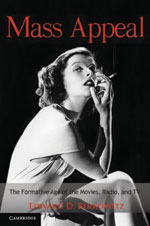A Spotlight on Entertainment's Early Years
 The world of entertainment teases and tramples, because it is positioned between fancy and fickleness, fame and failure. Some persons are needy for MGM-like stardom and entranced by the possibilities of large amounts of money, love, and—endless adoration.
The world of entertainment teases and tramples, because it is positioned between fancy and fickleness, fame and failure. Some persons are needy for MGM-like stardom and entranced by the possibilities of large amounts of money, love, and—endless adoration.
Usually, none of it lasts.
Edward Berkowitz's Mass Appeal: The Formative Age of the Movies, Radio, and TV (Cambridge University Press, 2010) is a comprehensive, readable history of American diversion. Vignette-style, the history, public policy, and public administration professor reviews the trends and household names that contoured the evolution of American leisure from 1920 to 1970.
In the beginning, there were vaudeville acts and nickelodeons. But when the Warner brothers gambled on the feasibility of fusing sound with celluloid, technology jumped to short talkies. Suddenly, the seductresses Theda Bara and Clara Bow were obsolete, and Charlie Chaplin emerged as "the most famous performer from the silent era who was able to sustain his fame into the era of talking pictures, unlike Bara, Bow and Pickford…"
With the 1929 release of The Jazz Singer, movies progressed to longer productions with music. In the 1930s Katharine Hepburn catapulted to renown via Broadway, as did the Marx Brothers, Fred Astaire, and Ginger Rogers. The stage provided an alternative pounce to the Hollywood dream, even if—statistically—so few fulfilled it.
For the Marxes, triumph was short-lived. After their movies Animal Crackers, Cocoanuts, and Monkey Business appeared, the formula was changed, and their audience fell away.
Hepburn, meanwhile, was victorious in Broadway's The Warrior's Husband, segued to an Academy Award win for Morning Glory, bombed in Break of Hearts, The Little Minister, Sylvia Scarlet, and Bringing Up Baby, and was declared box office poison. When she resurfaced in the stage and screen adaptations of The Philadelphia Story, the critics rescinded their harsh remarks.
Astaire and Rogers acted on stage separately but had their talents alchemized in 10 films that "relied on a fundamental trick," Berkowitz writes. "They made something that was inherently difficult look easy. The audience saw none of the trial and error that went into creating the routines, or the athletic nature of the work, complete with sweat and tumbles, that went into executing the routines. The fancy dress helped remove all that and put a polish on the performance…."
It was a time of escapism, and though movie attendance peaked in 1930—a Depression year—for the "average" American, it only meant that "someone in the habit of going to the movies twice a week might save money by going once a week." And, as Berkowitz observes, "Movies, like candy, were a cheap item that delivered a great deal of satisfaction, an affordable indulgence in hard times…."
By the time radio was visible, entertainment choices were multilayered. Regular, long-running serials were so popular that "many people had more than one radio in their house, and another for their car, so that in 1939 there were some 44 million radios in the United States, more radios than families…."
Like the stage and screen, the world of broadcasting created stars of its own; some were long lasting; others were not.
Abbott and Costello had an extended career in the medium but a short run in the movies. Lucille Ball starred in My Favorite Husband but did not become popular until the 1951 premiere of I Love Lucy. Jack Benny also succeeded in radio and TV—until 1963's Gomer Pyle put an end to his era. Only Bing Crosby and Bob Hope lasted the vicissitudes of radio, film, and television.
During the war most leading men were enlisted, which propelled the talented, older, and relatively unattractive Humphrey Bogart to stardom. Casting him in The Maltese Falcon, Casablanca, and the pairing with his future wife, Lauren Bacall, in To Have and Have Not assured him of his longevity—and their legend.
By the 1950s the studio system was unraveling. Spectaculars such as The Greatest Show on Earth, Singin' in the Rain, and An American in Paris were the MGM-Fox-Paramount-Warner-Universal juggernaut against the "Lucy" Armageddon. The networks also swiped at Hollywood for market share with their 30 westerns airing by 1958, and the subsequent inventions of Perry Mason, Dr. Kildare, and Ben Casey.
In time, film "miniaturized" and flowed into the home; Walt Disney, already acclaimed for Snow White, Pinocchio, and Fantasia, inaugurated Sunday night, family-themed television movies that began in 1954 and ended in 1990.
And, like film, Broadway, and radio, the small screen produced its luminaries. Woody Allen started as a writer, prior to making What's New Pussycat, Take the Money and Run, and Annie Hall, as did Larry Gelbart, creator of M*A*S*H.
By 1970 and beyond, Hollywood stars of yesteryear were returning to Broadway for brief runs. Radio no longer made stars like Jack Benny and Bob Hope, according to Berkowitz:
"Instead, performers struggle to get noticed on television—cable television … in the hope that they can go from there to the movies. Hope and Benny used vaudeville to get into radio and radio to get into television. Lucille Ball prepped for stardom in the movies and radio. Tom Hanks, John Travolta, and Clint Eastwood skipped the radio phase and did television shows before making it big in the movies. Changes in the media…altered the path to stardom, even as the radio, television, and movies…endured under changing circumstances."
—David Bruce Smith, BA '79
